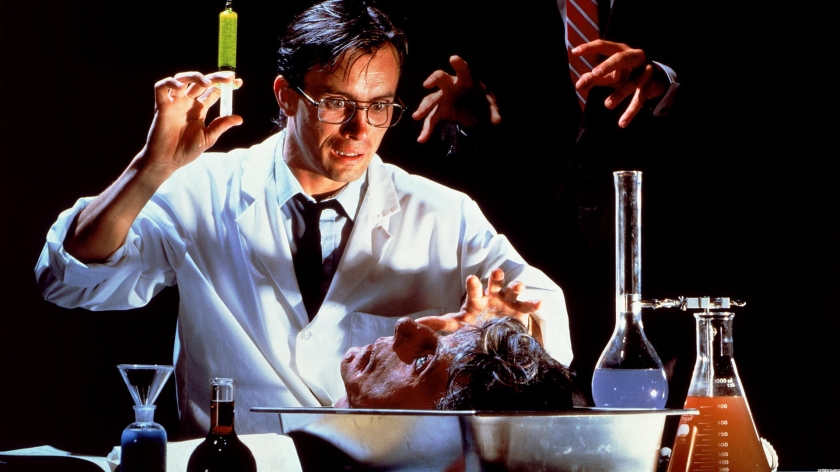The Dunwich Horror (1970)

Adapting the work of horror writer H.P. Lovecraft is a challenge for any screenwriter, or director. Like Poe, much of Lovecraft’s power lies in his verbiage. His horrors are the concealed, obscure terrors of dreams, and his writing chock full of purple prose invoking nameless fears and indescribable stenches from dark Cyclopean caverns. Moving that kind of writing to the big screen is nearly impossible, because Lovecraft trades on things that cannot be seen or, once seen, cannot be described.
The Dunwich Horror makes a good attempt at adapting one of Lovecraft’s better known stories to a visual medium. The film was directed by Daniel Haller from a script co-written by Curtis Hanson, who would go on to direct L.A. Confidential and The Hand that Rocks the Cradle. It was produced for Roger Corman’s American International Pictures, which immediately indicates what we can expect from the production.
Following a bizarre birth sequence and some truly epic opening credits, the film properly begins with the introduction of Wilbur Whateley (Dean Stockwell, looking more 70s than I thought was humanly possible). Whateley wants access to the dangerous and forbidden book of black magic, the Necronomicon, stored in the library of Miskatonic University and owned by Dr. Henry Armitage (Ed Begley, in his final film role). To this end, Wilbur hypnotizes one of Armitage’s students Nancy Wagner (Sandra Dee) into furnishing him with the book. When Armitage appears and refuses to allow Whateley to take the Necronomicon away with him, Whateley puts another plan into action: he has Nancy drive him home to Dunwich, where he lives in a ramshackle old house with his grandfather (Sam Jaffe, having the time of his life) and something vague and rumbly in the attic. It soon becomes clear that the Whateleys are a weird and creepy family (if we didn’t know that already), and Nancy will be their next victim in an arcane ritual designed, as most things are, to bring about the end of the world.
Anyone who has read the original Lovecraft story will recognize the initial plot about the Whateleys, and also that the whole “sacrifice a virgin to the Old Ones” is nowhere close to that story. The Lovecraft narrative deals more with the birth of Wilbur, his upbringing, and the fear he inspires in the townspeople of Dunwich prior to the arrival of “the horror” in the title. The narrative then shifts to the “Dunwich horror” and how the townspeople discover it and defeat it with the help of Armitage and the local doctor.
The film of The Dunwich Horror ignores most of the first part of the original story and focuses on the underlying theme of sexuality, present in much of Lovecraft’s work. Wilbur’s seduction of Nancy is accomplished through drugging her drink, hypnotizing her, and finally having sex with her on a stone altar – the entire sequence, though not explicit, plays like a soft core porn film that pretty much kills Sandra Dee’s virginal teenage image for good. The point of this part of the plot is unclear, save that the opportunity to show Dean Stockwell and Sandra Dee having kinky altar sex was too good to pass up.
Dean Stockwell takes the lead in this film, his fabulous mustache and 70s perm really hammering home the change of time period from Lovecraft’s – although it does match the “decadence” that Lovecraft finds so horrifying. But he’s also that combination of creepy and charming that makes his eventual seduction of Nancy believable, even if we wonder why any sane young woman would agree to get in the same car with a man who looks and talks like a pimp. Sandra Dee gives a perfectly serviceable performance as Nancy, although not much is demanded of her beyond being innocent and then writhing around on an altar. The elder actors are having a lot of fun with their respective roles, especially Sam Jaffe, who wanders around the house making arcane pronouncements and shouting in the face of his grandson.
The problem with The Dunwich Horror is that there’s not much horror to go around. The film spends more time on the inevitable seduction of Nancy than it does on building up the terror surrounding the thing that rattles the attic door. However, I will give the film praise for creating an invisible “lurking terror” which, when it finally breaks loose, does its evil very effectively. The climax of the film does not quite work, however, as we’ve spent far too much watching Nancy become the vessel of the Old Ones and far too little time with reasons why that is a bad thing. I never thought I’d say this, but they needed to inject a little less attempted subtlety and a little more Lovecraft.
At the end of the day, The Dunwich Horror is a good, but not great, B-level Corman production. It’s never dull, and is actually far better than I expected it to be. Still, I wanted a bit more horror to go with my Dunwich.










